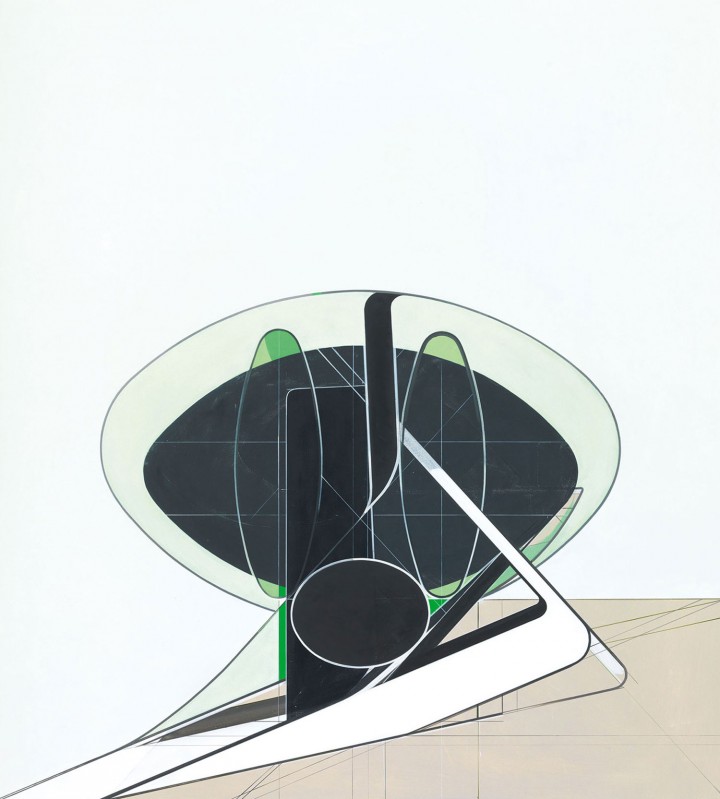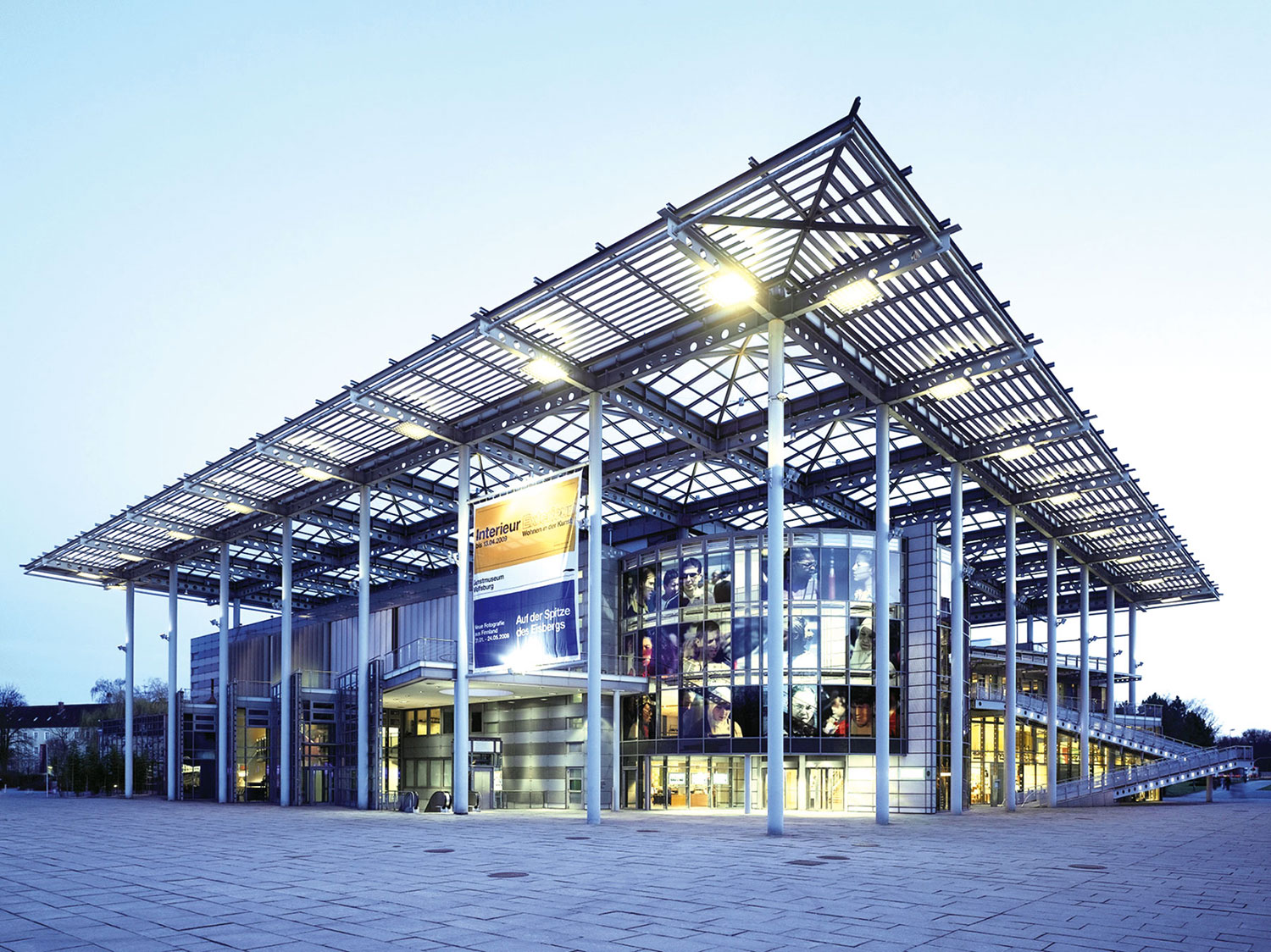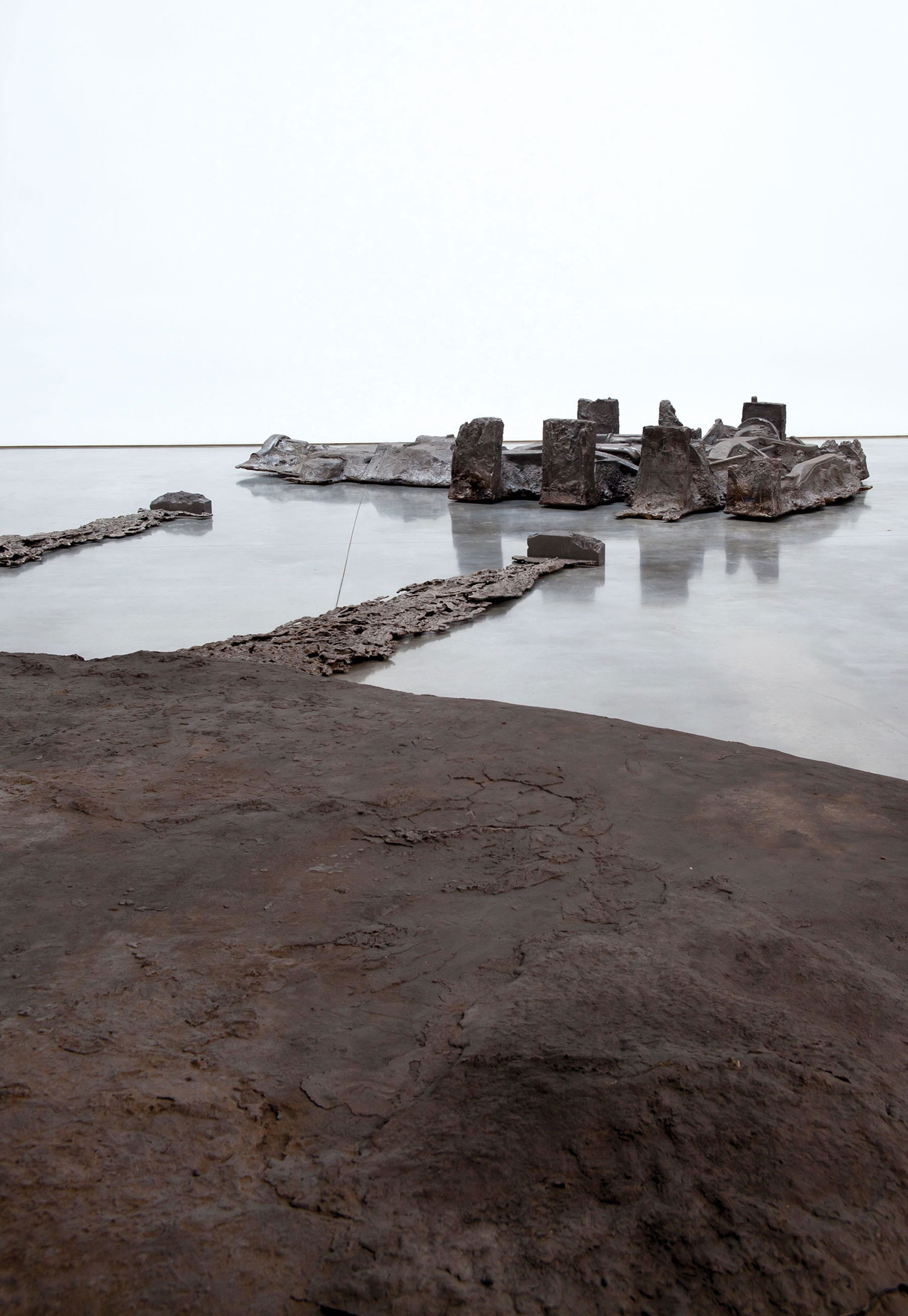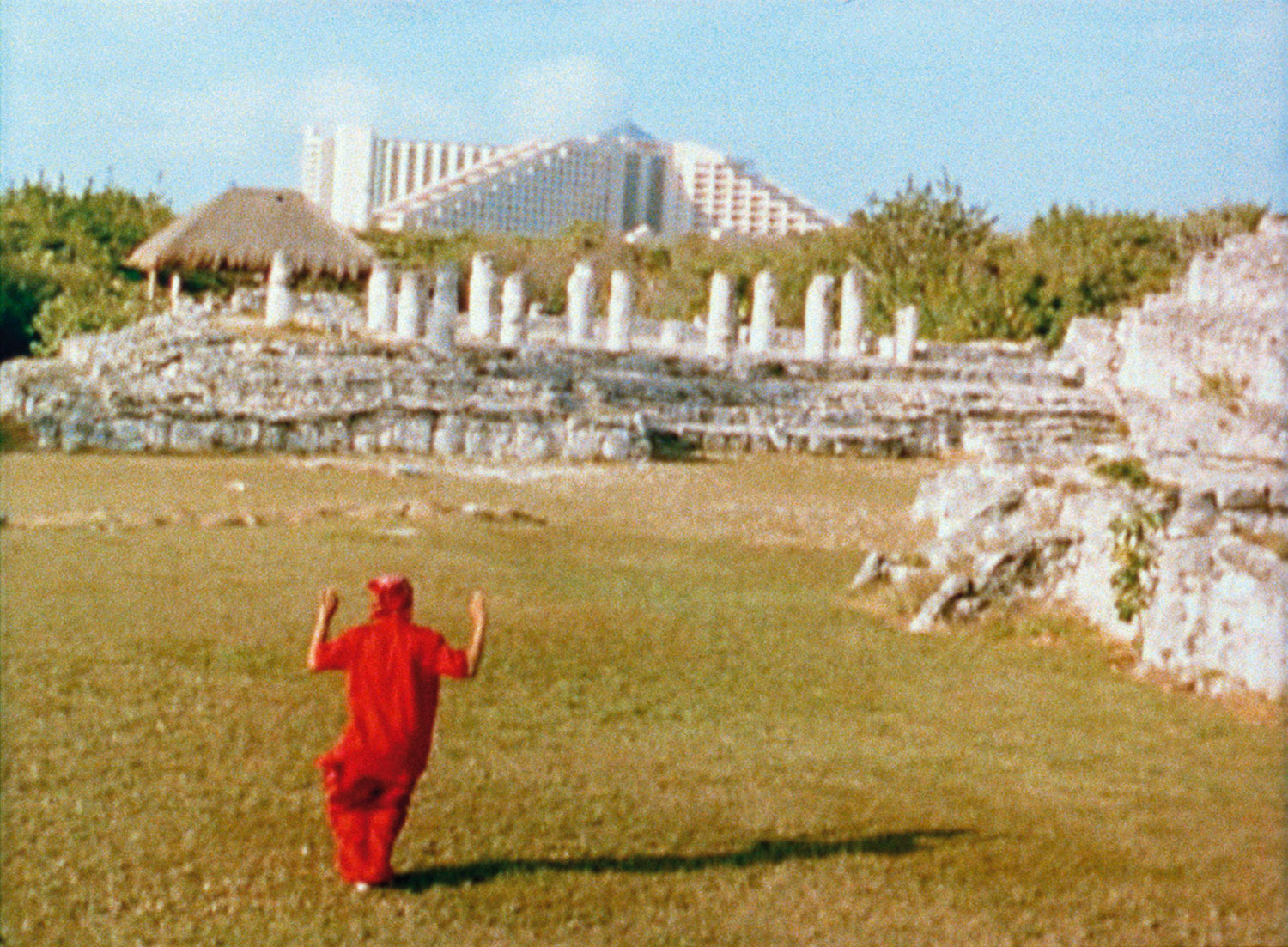
Viktor Neumann: I would like to talk about the role of space and spatiality in your work. What role do pictorial as well as factual or architectural space play both in your thinking and working process? What spatial situations and concepts are you working with?
Frank Nitsche: In comparison to Katharina’s, my work functions within the four points on the painting surface: I am interested in the spatial situation on this surface.
Katharina Grosse: I am interested in the immersion and emergence of the factual pictorial space and the interactions resulting from this process. In my studio I also work with canvases, isolating the imaginative pictorial space. However, spatiality always results from simultaneous factual and imaginative spatiality. My big spatial works are like a visualization model of this interaction, and often one’s own body becomes an element. The given architecture is just one among other already defined parameters. I am interested in the relationship between the object and the surface, which also plays a big role in my canvas works. The picture field is a surface which then re-articulates itself spatially when the background becomes sculptural. There are different possibilities for becoming sculptural: one can work with the minimal, conspicuous or even destructive sculptural, and then let it function against the picture field. My aim is to try out the whole spectrum.
FN: Though I deal with the architecture while installing an exhibition, principally I am just interested in the problems within the four pictorial vertices; that is already plenty to deal with. Objects, sculptures and my photographic archive are parallel works. The design, overlaps, interferences and spatial conditions in my sculptural works exist in my paintings as well, of course. In painting I am interested in specific compositions, and this is a very different approach concerning the picture field. I have to concentrate on my paintings to create a new, specific picture field both in terms of composition and color. It is a cognitive process and one of understanding — it is always continuous. Right now I am trying to paint spatial entities.
KG: I agree that the question of picture spatiality is very complex. I try to explore it closely within my spatial works. The spatial work functions like a magnifying glass under which I can take apart and decelerate everything. There is a different speed and acceleration in the condensed form of the canvas works. This is why I see them as parallel to each other. How can an image create spatiality within the spatiality of the picture itself, which isn’t figurative or produced under figurative conditions? I have the feeling that you work the opposite way, Frank.

FN: I am also not mainly interested in figures. I am more interested in the picture spatiality emerging in the work process. Figures are a means to an end: to create a specific spatiality.
KG: Exactly, you come from the opposite way since the quotations are no longer clearly visible nor are they definite.
FN: I want to keep my works free from quotes. Continuous quoting gets on my nerves right now, and it also shows helplessness. Concerning dimensions, it is really hard for me to produce small works, but I have to do them. Sometimes small pieces take much longer to get done than bigger ones. Due to its materiality, big pieces have already an overwhelming nature to be materially experienced in themselves. But I also expect a small picture to be able to fill a big room and I have been working with this in mind.
KG: There is a certain rawness of movement in my practice that is barely possible to show in small dimensions. I am interested in the field where there is no clearness yet, where the direction of the form is still open and as plural as possible. The medium I chose is incredibly fast, and I am fascinated by the possibility to completely invert a work through one or two actions.
FN: I also sometimes delete half of a picture and repaint an area to get a completely different one. Those radical decisions are obviously easier with works of small or medium-sized dimensions. On some of the paintings I work for two or three years, get them out again and again and repeatedly strip them. Sometimes that entails quite a long process, and I want them to convey an appearance of smoothness. I like what Francis Bacon said about transmitting a feeling without the dullness of the transmission — to not see that one worked for two years on a picture. It should evoke effortlessness.
KG: My installations are incredibly time-bound. The scale of the single components of an installation allows a shift in the psychological perception of time. My spatial decisions are therefore dramatic decisions as well. A simultaneity of emotions emerges through the condensation of space and time, which can be as various as extreme enthusiasm, repulsion, love or excitement. I appreciate in painting the phenomena of allegedly contradicting things becoming simultaneously visible.
VN: Both of you work with the method of layering. Could you tell me more about the decision process concerning form and color? What functions do form and color have in your works? Is there a clear endpoint to one work or do you think about it more in terms of a continuous process?
FN: In fact my works never have a real end point. My pictures show my current state of knowledge, which changes constantly, so I would rather describe it as a process. It’s hard to decide whether a picture is finished; it’s mostly determined by a deadline, otherwise I could go on painting it perpetually.
KG: Yes, a clear end point would suggest the existence of an absolute achievement. I’d rather describe my works as snapshots of specific situations: If you go on painting, you overpaint, but if you decide to conserve this state of knowledge, then you stop. At the same time, I find the possibility to discover the substantiality of the layers very fascinating. There is always a certain feeling for the presence of the layers that are no longer visible. If you hypothetically overpaint a red area with green, the presence of the red, though not visible, still exists; the erased is still latently perceptible and responsible for the layer coming over it.

FN: Actually, thinking about color comes secondary in my paintings. Primarily I’m interested in form. I don’t conceive green, for example, as a color but rather more like an alien element in and towards the picture that I consciously put in as a disruptive factor.
KG: Though color is a kind of elixir for my work, it’s not an element for examination. I am rather interested in the simultaneity of incompatible conditions within the work, and color is being used to make this clear. Of course it has the function of creating a physical closeness. Like the voice in a song, color has a strong evocative power. It is hard to determine it in opposition to pictoriality when it is figurative. Color can’t be spatially determined. It’s essentially atopic, and I find this condition highly interesting, especially in my spatial works: since color has no space that can be defined, color can occur everywhere, it can be deposited everywhere and therefore change the spatial situation. And that’s how I can change the surrounding and declare my displeasure towards certain given conditions. Furthermore I am interested in the simultaneity of color and lines. To assign a body to a surface establishes specific hierarchies and balances of power, relations that aren’t easily changeable. Color can make these relations unclear.
VN: It seems to me that a common element in your practices is to perform a continuous transformation of meaning and attribution on allegedly ontological, hierarchical and representative levels.
KG: Yes, this becomes very distinct in my spatial works. Object boundaries are being dissolved here through something as harmless as color and color movement. Then, a direct contact with the surrounding takes place, without reacting with ideological discussions or recourse to quotations. This is how I can resist my surroundings, the situation one is confronted with — resistance to specific social conditions, systems and institutions that we construct though they are just meant to remain static. Systems always want to maintain themselves and it is highly difficult to keep such systems fluid, but this flux is what I find fascinating in the possibilities of thinking.
FN: Through various influences I try to create a context that is universal. For example, in my pictures I want to push a specific design through destruction and deformation ad absurdum. At the moment I am highly interested in geometry and especially symmetry, which you have to split open so that it won’t get boring, of course.
KG: Your new works seem like a sketchbook of someone trying to invent a new form of writing not bound to a function. There is something anarchic about it since this symmetry, or the formation of signets, is power-oriented as well; let’s say one wants to organize specific structures. I have the feeling that though you are using this approach you release it from any function.

VN: What other cultural or everyday phenomena have influenced your thinking and your work?
KG: I am extremely interested in the strategies of field sports, the spatial sectioning in team sports for example — how a team works together or anticipates certain situations. I have recently read Jonathan Wilson’s Inverting the Pyramid: The History of Football Tactics (2008). I am also interested in how people develop creativity in rigid systems. Competitive sports are like paramilitary disciplines. I have recently seen Ryan Trecartin’s exhibition at MoMA PS1, and his videos are quite astonishing. Especially exciting is the way he deals with various interfaces in society. The works are crowded, bulging and remarkably produced. In my work there is also constant interfacing. In 2004 I made a painting of my own bedroom (the walls, floor, my bed, books, clothes) just the way I had left it the previous night. A bed is an interesting shape, it functions like a frame, with a mattress stretched to almost become a horizontal sculpture of a surface for projection. This work was not just about questioning the quotidian, but also about symbolism-imbued materials. Untitled (2004) presented a turning point for me: since then I have allowed more plural elements into my work.
FN: As for me, I would rather ask myself which materials don’t have any influence.





